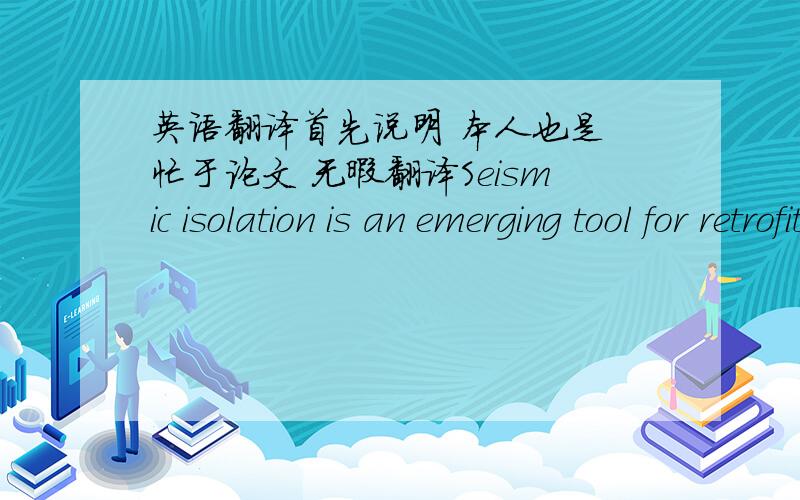英语翻译首先说明 本人也是 忙于论文 无暇翻译Seismic isolation is an emerging tool for retrofitting bridges.The concept of seismic isolation aims to decouple the superstructure from the horizontal components of the ground motion wit
来源:学生作业帮助网 编辑:作业帮 时间:2024/11/25 07:26:59

英语翻译首先说明 本人也是 忙于论文 无暇翻译Seismic isolation is an emerging tool for retrofitting bridges.The concept of seismic isolation aims to decouple the superstructure from the horizontal components of the ground motion wit
英语翻译
首先说明 本人也是 忙于论文 无暇翻译
Seismic isolation is an emerging tool for retrofitting bridges.The concept of seismic isolation aims to decouple the superstructure from the horizontal components of the ground motion with isolators that have a low horizontal stiffness.Analytical and experimental research and monitored performances of seismically isolated structures during past earthquakes provide ample evidence of the effectiveness of this technology for protecting bridges prone to seismic hazards [28; 3; 15; 12].
Despite being considered a relatively mature technology,the use of seismic isolation in bridges has been impeded due to delays in official design guidance and conservatism.The Specification [2] still does not provide guidance about selecting the optimal isolator type for different bridge applications.Another factor that has impeded the wide-spread use of seismic isolation in bridges is over-conservative attitudes [17; 20].The responses of state bridge engineers on a survey asking why seismic isolation is not more widely used revealed that engineers are not comfortable with seismic isolation because they view it as a black box and that there is a lack of certainty on choosing the optimum type of isolator [17].
Isolators can be broadly classified as sliding and elastomeric [27; 2].Among others,two isolator types that are representative of sliding and elastomeric systems are the Friction Pendulum System (FPS) and the Lead-Rubber Bearings (LRB),respectively (Figure 1).It has been reported that the cost,size and energy dissipation of the FPS and LRB may be comparable in bridge applications [8].Additionally,both isolators have been incorporated into the design codes [2;11].However,there are unique differences in the vertical response characteristics of elastomeric and sliding isolators.The conventional FPS is essentially rigid under compression and has no tensile load capacity while the LRB has relatively less compression stiffness and able to resist a limited amount of tensile loading [20; 3; 14].Both the post-yield stiffness and the yield force of the two types of isolators are known to be affected by the normal force being imposed,but at a different rate and form [3; 23].Normal force-dependent FPS models have been developed previously to show that this effect may result in considerable variation on the estimated isolator response [3].However,LRB models that account for normal force-dependency has not yet been extended to account for and implemented in bridge analyses to the authors` knowledge.
楼下两位仁兄速度真快啊 我知道你是小号刷分
英语翻译首先说明 本人也是 忙于论文 无暇翻译Seismic isolation is an emerging tool for retrofitting bridges.The concept of seismic isolation aims to decouple the superstructure from the horizontal components of the ground motion wit
Seismic isolation is an emerging tool for retrofitting bridges. The concept of seismic isolation aims to decouple the superstructure from the horizontal components of the ground motion with isolators that have a low horizontal stiffness. Analytical and experimental research and monitored performances of seismically isolated structures during past earthquakes provide ample evidence of the effectiveness of this technology for protecting bridges prone to seismic hazards [28; 3; 15; 12].
隔震是为桥梁抗震加固的一项新兴技术.隔震的概念是利用水平刚性较低的隔离器,减弱来自地面运动水平分量的震波对上部结构的影响.根据分析与实验研究以及对隔震结构在以往地震中的性能监测,已充分证明该技术对保护地震区域桥梁的有效性 [28; 3; 15; 12].
Despite being considered a relatively mature technology, the use of seismic isolation in bridges has been impeded due to delays in official design guidance and conservatism. The Specification [2] still does not provide guidance about selecting the optimal isolator type for different bridge applications. Another factor that has impeded the wide-spread use of seismic isolation in bridges is over-conservative attitudes [17; 20].
尽管这是一项相对成熟的技术,然而,由于官方设计指引的延误及保守主义的原因,导致隔震技术在桥梁上的使用受到阻碍.该‘规格’[2] 还是没有针对不同的桥梁,提供指导哪种是最合适的隔离器.另外一个阻碍桥梁广泛使用隔震技术的因素是守旧观念 [17; 20].
The responses of state bridge engineers on a survey asking why seismic isolation is not more widely used revealed that engineers are not comfortable with seismic isolation because they view it as a black box and that there is a lack of certainty on choosing the optimum type of isolator [17].
根据一项对国家桥梁工程师的调查中,问及为何桥梁不广泛使用隔震技术,回答显示他们对使用隔震技术感到不自在,因为他们将之视为黑匣子,而且对采用哪种最佳的隔离器存有疑惑[17].
Isolators can be broadly classified as sliding and elastomeric [27; 2]. Among others, two isolator types that are representative of sliding and elastomeric systems are the Friction Pendulum System (FPS) and the Lead-Rubber Bearings (LRB), respectively (Figure 1). It has been reported that the cost, size and energy dissipation of the FPS and LRB may be comparable in bridge applications [8]. Additionally, both isolators have been incorporated into the design codes [2;11].
隔振器一般可以分类为滑动与弹性型 [27; 2].其中最有代表性的是滑动型的摩擦摆系统(FPS)以及弹性型的铅芯橡胶支座(LRB)[图1].据报道,桥梁采用FPS与LRP的成本、尺寸及消能减震与其他方式都具有可比性 [8].而且,这两种隔离器已被纳入设计规范中 [2;11].
However, there are unique differences in the vertical response characteristics of elastomeric and sliding isolators. The conventional FPS is essentially rigid under compression and has no tensile load capacity while the LRB has relatively less compression stiffness and able to resist a limited amount of tensile loading [20; 3; 14].
不过,弹性与滑动型隔离器的竖向反应特性具有独特的区别.传统的FPS受压时本质是刚性的,也没有抗拉承载力;而LRS的压缩刚度相对较小,可以抗拒有限的拉伸载荷[20; 3; 14].
Both the post-yield stiffness and the yield force of the two types of isolators are known to be affected by the normal force being imposed, but at a different rate and form [3; 23]. Normal force-dependent FPS models have been developed previously to show that this effect may result in considerable variation on the estimated isolator response [3]. However, LRB models that account for normal force-dependency has not yet been extended to account for and implemented in bridge analyses to the authors` knowledge.
这两种隔离器的屈服后刚度及屈服力被认为会受法向力的影响,但比值和形式不一样[3; 23].以前开发的法向力式FPS模型显示这种影响对估计隔离器反应的结果有相当大的差异 [3].不过根据作者了解,依赖法向力的LRP模型还没涉及到桥梁的使用分析中.
【英语牛人团】